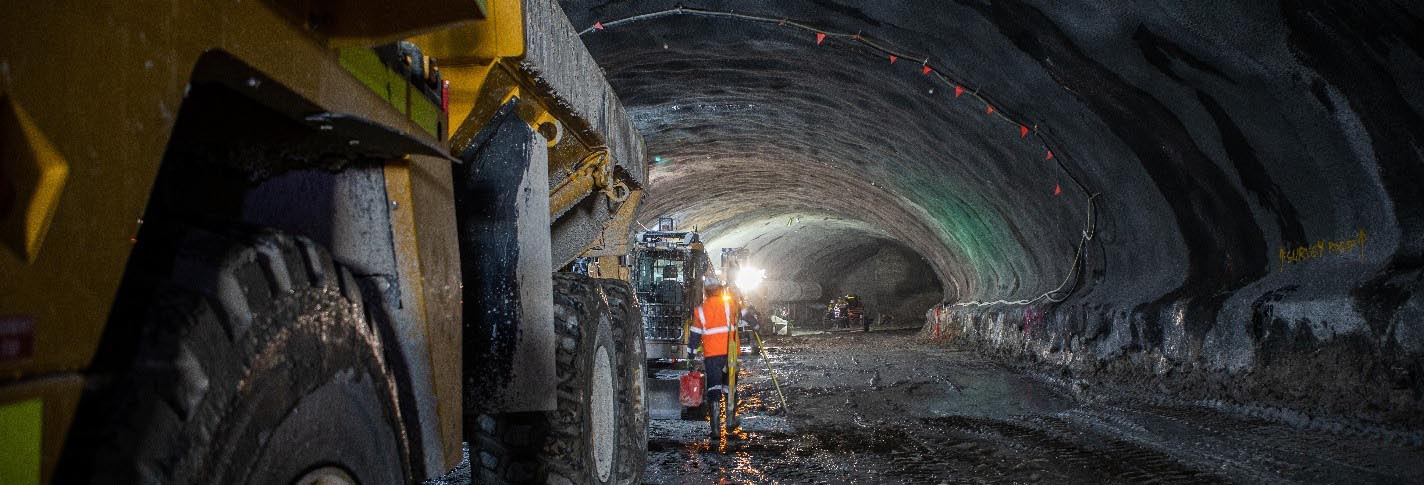ArchitecturalUndergroundStructuralGeneralUpdated Fiber-reinforced Shotcrete Testing Standard — Faster, Easier and Better!
Bill Gears and Benoit de Rivaz
Read MoreThe updated fiber-reinforced shotcrete testing standard in underground projects provides not just significant cost savings, but just as critical, helps us to significantly reduce the carbon impact of the underground construction industry and provide for a better environment and future for us all.
RepairUndergroundStructuralThe Rondout Bypass Tunnel Shafts – Shotcrete Lining
Paul Madsen, Bade Sozer, Thomas Hennings, & Eileen Test
Read MoreThe Rondout-West Branch Tunnel (RWBT), a segment of the Delaware Aqueduct (the Aqueduct), was built from 1937 to 1944 and provides about 50% of New York City’s total water supply. The tunnel is concrete lined and has a finished inside diameter of 13.5 ft (4.1
RepairUndergroundStructuralTAKING TUSCARORA INTO ANOTHER CENTURY
Kristina Smith
Read MoreThe Tuscarora Mountain Tunnels in Pennsylvania have a fascinating history. The older of the two tunnels, built between 1938 and 1940, was designed to carry a railroad that never came into service. Industrialists of the day, William Henry Vanderbilt and Andrew Carnegie, were backers of
UndergroundEXCHANGE PLACE STATION – 9 CAR PROGRAM WEST CORRIDOR
George Machikas
Read MoreExchange Place Station 9-Car Program is a vital part of the $1 billion PATH system improvement plan unveiled in 2019. The improvements to the 111-yearold system will allow for longer 9-car trains on the Newark/ World Trade Center Line. The objective was to add capacity
UndergroundStructuralInternationalSHOTCRETE AT MT PLEASANT STATION
Shaun Radomski, Lloyd Keller, Daniel Sanchez, Dudley R. Morgan
Read MoreMulti-million dollar underground stations are currently under construction on Metro and LRT lines in Toronto, Ontario, Canada. Traditionally, the thick, heavily reinforced structural concrete station walls have been constructed using the conventional form-and-pour concrete construction method. This construction method, while widely used, is not without
UndergroundStructuralMount Pleasant Station, Part 1: Preconstruction Qualification for Shotcreting of Mass Concrete
Shaun Radomski; Dudley R. (Rusty) Morgan, Ph.D., F.ACI; Lloyd Keller, F.ACI; Daniel Sanchez; & Laura Di Monte
Read MoreMulti-million-dollar underground stations are currently under construction on Metro and LRT lines in Toronto, Ontario, Canada. Traditionally, the thick, heavily reinforced structural concrete station walls have been constructed using the conventional form-and-pour concrete construction method. This construction method, while widely used, is not without its
PoolRepairArchitecturalUndergroundStructuralInternationalRecreationalGeneralThe Jetcreter – The First Continuous-Feed, Dry-Mix Gun
Ted Sofis
Read MoreDuring the summer of 1970, on my 18th birthday, my father woke me up and told me they needed me on a job. I drove out that morning in July to the Crucible Specialty Steel plant in Midland, PA. It was my first experience working
UndergroundStructuralMapei’s London Underground Bank Station’s Capacity Upgrade
Enrico Dal Negro, Stefano Anzani, & Steven Price
Read MoreDeep in the heart of London’s financial centre, work has been continuing to make one of the world’s largest stations safer and easier for passengers to use. Finding your way around the existing labyrinth of tunnels, connecting five London underground lines, is a task worthy
RepairUndergroundStructuralAdvances in Shotcrete Technology for Ground Support in Tunnels and Mines in North America
Lihe (John) Zhang, Ph.D., P.Eng., F.ACI & Dudley (Rusty) Morgan, Ph.D., F.ACI
Read MoreIn recent years, shotcrete has been widely used for ground support in civil tunnels and mines in North America. Shotcrete technologies have advanced with robust robotic sprayers, high-performance shotcrete mixture designs, and high-performance fiber reinforcement in conjunction with rigorous qualification of shotcrete nozzlemen and QC
UndergroundInternationalM4 M5 Link Tunnels
David Oliveira
Read MoreThe M4-M5 Link Tunnels in Sydney, Australia, is approximately 7.5 km (4.7 mi) long and accommodates up to four lanes of traffic in each direction. It connects the New M4 Tunnels with the M8 Tunnels to form the 33 km (20 mi) long Westconnex Motorway, mostly underground.

